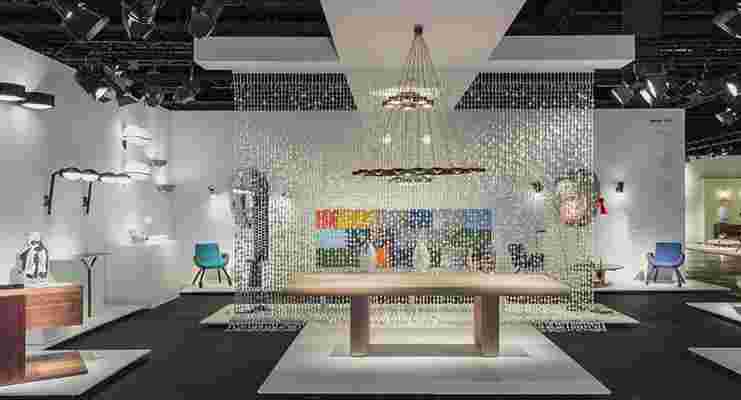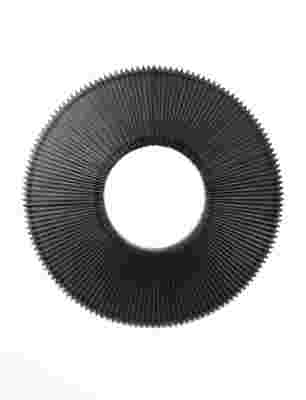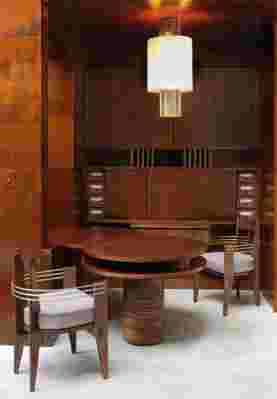Few editors would describe a design fair as relaxing— Milan’s Salone and Paris’s Maison&Objet are vast, the booths packed, and the days long. But after a morning at Art Basel, where thousands of artworks are on display, I found respite at Design Miami Basel, next door to the art fair. Maybe it was the scale, or the soft, conducive lighting. I could tour the two-floor exhibition space in less than an hour and walk out revived—and inspired. Cutting-edge design is, of course, on display, in the form of the late Zaha Hadid’s Liquid Glacial collection of acrylic stools and tables as well as the serene stone tea house created by Masatoshi Izumi and Koichi Hara. The blue-chip vintage pieces, however, were the real targets for the excitement (and purchases). They remain timelessly elegant and desirable. Like at the art fair, the best pieces sold within an hour of opening. Here’s what caught—and held—my attention at Design Miami Basel 2016.

Galerie Kreo is famous for its vintage lighting—after all, owner Didier Krzentowski has been collecting superb lighting for 30 years. But I coveted one new piece from this savvy Parisian dealer: a whimsical curtain by Hella Jongerius that’s made of porcelain beads and knotted rope. It’s easy-breezy and impossibly chic. Her original piece hangs in the U.N. in New York, installed in the Delegates Lounge in 2013. The summery curtain would look right at home in a beach house, chiming in the breeze, or in a minimalist loft separating, say, the living area from the kitchen.

I could move right into the room that the charming French couple, Matthieu Richard and his wife, Sophie, set up with vintage furnishings by the Hungary-born, Paris-based midcentury designer Mathieu Matégot. Almost everything sold on the fair’s first day, and why not? The pieces had a transparent, light-as-air look, vaguely industrial yet elegantly simple—notably a pleated-metal mirror and a perforated-metal chair, both lacquered black. “He worked like a couturier,” Richard told me. “Every six months a new collection, and then he changed everything.”

The standout piece at Galerie Alain Marcelpoil was the personal desk of the genius French designer André Sornay , whose creations brilliantly bridged Art Deco and modernism. Sornay’s desk set (complete with lighting and chairs) made its debut, in 1937, at an arts exhibition in Paris. Crafted in mahogany and brass, the all-in-one office not only served as a showcase for what the designer could make for clients but also formed a unified work space that’s as functional as it is glamorous. The trio of linked circular tabletops spin like lazy Susans.
Marc Barbezat was an important midcentury French publisher, and when he wasn’t working, he wanted to surround himself, literally, with his books. In the late 1960s, he commissioned Diego Giacometti to design a room-size shelving unit for his home in Paris. The L-shaped piece, intricately fashioned in shimmering bronze, frames an inset bed, ideal for reading and resting. This extraordinary work is on view at the booth of Galerie Jacques Lacoste (of the famous fashion brand). The dapper dealer confided that the piece had not yet sold. “It’s museum-worthy,” he says, “but you have to have enough space.”
This content can also be viewed on the site it originates from.
Patrick Seguin is obsessed with Jean Prouvé. The French dealer lights up when describing his favorite modernist, and while the two Prouvé modular houses he installed inside the design fair are for sale (both in the $3 million range), only a handful of the vintage Prouvé furnishings are. “It’s hard for me to part with them,” says Seguin, as I hovered by a curved wood desk with green-painted metal drawers. This ideal writer’s desk, designed in the mid-1950s, was owned by L’architecture d’Aujourd’hui editor André Bloc.
